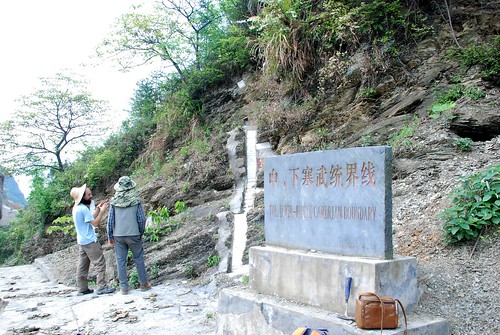On one of the Guizhou forays, we drove most of the way up a mountian to one of the Miao villages at Kaili. We then walked up the rest of way, to get to a building site... walkways, quarries, handrails (necessary in places)... and grand, triumphant proclamations that here, at this very spot, is where the Early Cambrian became the Middle Cambrian.
More accurately, the section is a potential stratotype for the base of the Middle Cambrian (stage C3). What does that mean? Well, one of the basic problems in interpreting the geological past is correlating rocks from one place (or continent) to another. We can't just date everything by using radiometric methods (it's very expensive, only works for certain types of rock, and normally isn't that accurate for single data points), so we've got to correlate them. To do that, you need to pick a point to correlate them with... that's a stratotype.
The stratotypes mark the base of each unit of geological time (or will once they're all decided); there, and only there, are the time units defined. If we say that some rocks in Wales are of Middle Cambrian age, it means that we've got a very good reason for believing that it was deposited after the point in time that is marked on a rock, up a mountain in China (and before wherever the base of the Late Cambrian is defined, of course). At its simplest, the reason might be that it contains a group of trilobites that only appear in China above that level; normally the arguments involve lots of cross-correlation, for example with Norway, then Estonia, then in turn with Iran, then with Malaysia, which finally lets us correlate with China... It's an odd concept, but when you think about it, it's the only good way of doing it. Nothing else is reliable or meaningful for making sure that people in all continents are really talking about the same time.
A committee chooses each site very carefully. Does it have a mixture of different fossils that can be used for correlation? Does it coincide with local changes in sea level or sediment changes that could confuse things? Is the structure chopped about by faults? Is there a good pub nearby? Actually, the latter plays little part, unless you need a two-hour helicopter ride to get to the place (which is a problem for one of the other candidates, in Siberia.)
This one, in the Kaili Formation, isn't too bad. There are lots of trilobites, which are useful for dating things, but few of other groups (no acritarchs, for example, which would be better). It's not been metamorphosed, but there are a few small faults. It's not easy to get to (up a mountain near Kaili City), but could be a lot worse. I understand the decision on which section gets the honour is due in a couple of months... can you all stand the tension?
Monday, 23 May 2011
Practical geological dating...
Subscribe to:
Post Comments (Atom)


No comments:
Post a Comment